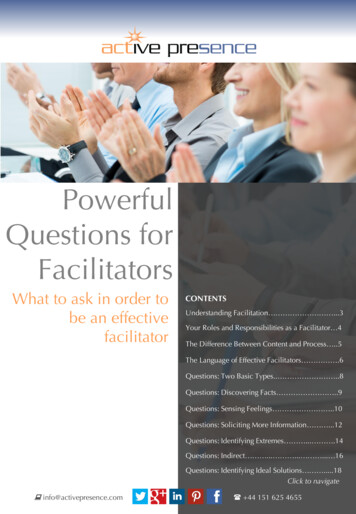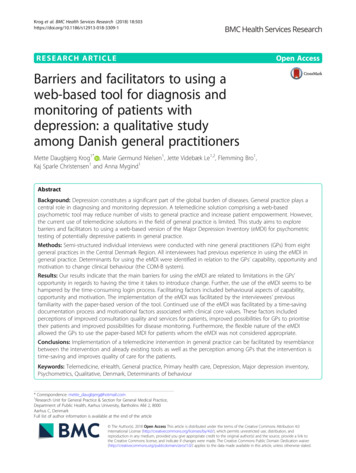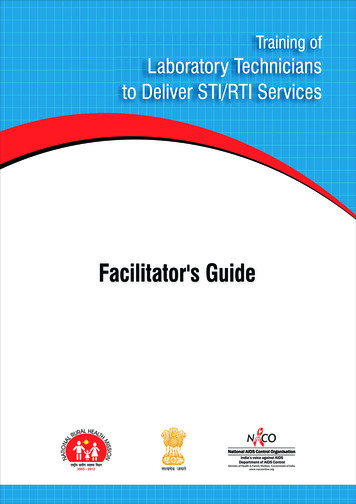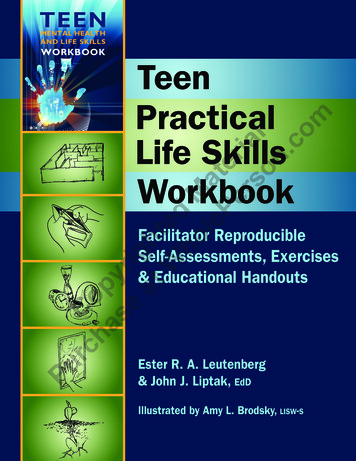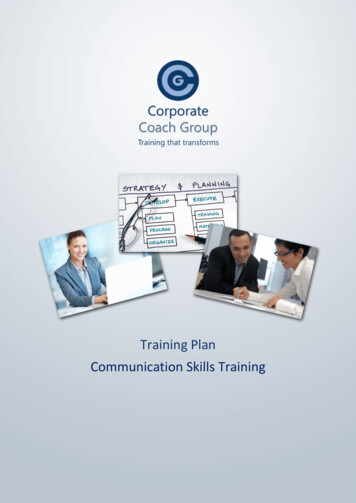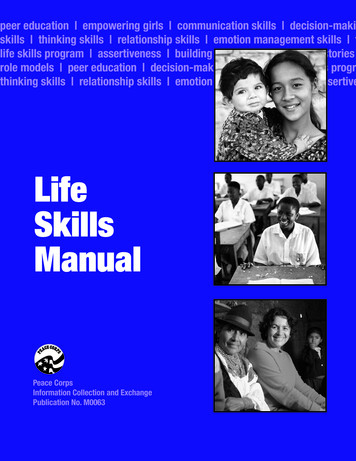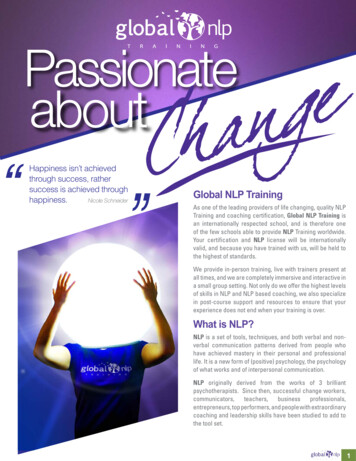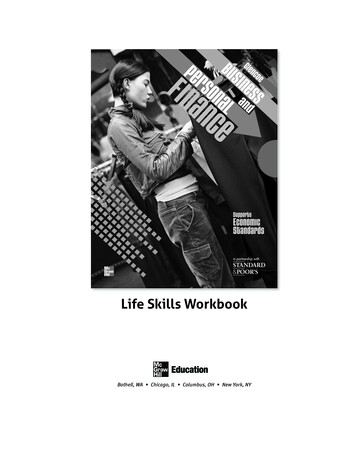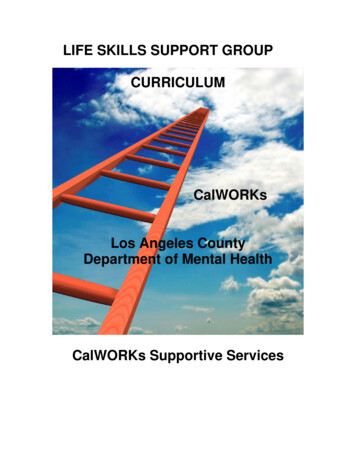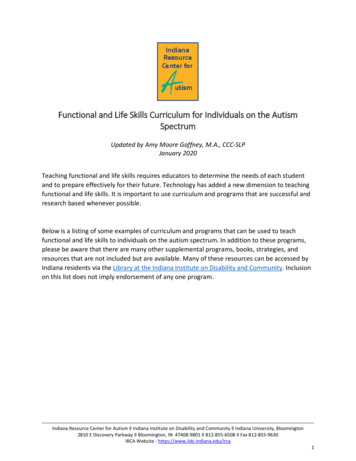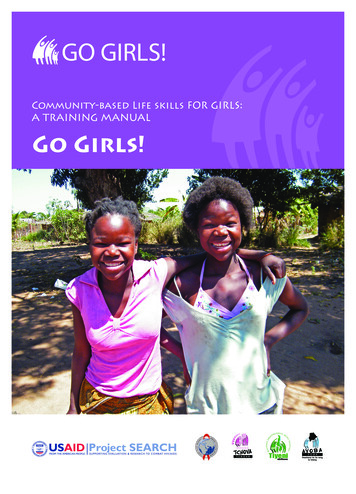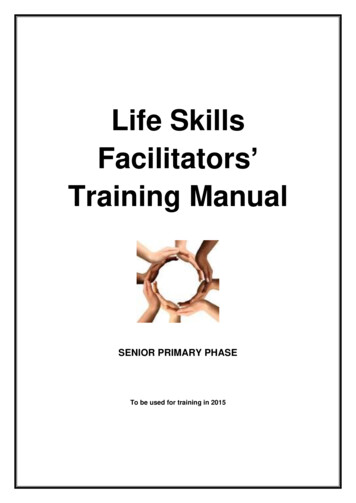
Transcription
Life SkillsFacilitators’Training ManualSENIOR PRIMARY PHASETo be used for training in 2015
Ministry of EducationNational Institute for Educational Development (NIED)Private Bag 2034OkahandjaNamibia Copyright NIED, Ministry of Education, 2014Life Skills Facilitators’ Training Manual Grade 4 - 7ISBN: 978-99945-2-100-5Printed by NIEDWebsite: http://www.nied.edu.naPublication date: 2014
PROGRAMMEDay One RegistrationOpening / welcoming remarksIntroduction of facilitator and participants; presentation of house rulesBackground informationTea/coffee breakCircle of Support to ensure the success of Life SkillsAlice in WonderlandIce BreakerWorkshop objectivesLunchEnergiserInclusive educationLearner-centred educationMethodology Opening; signing of attendance listRecapturing Day OneThe characteristics of a Life Skills teacherTea/coffee breakPlanningLunchPlanning (continue)Energiser (Facilitator can use his/her own initiative)Feedback on planning Opening; signing of attendance listRecapturing Day TwoLesson preparationTea/coffee breakLesson preparation formContinuous Assessment formLunchEnergiserLesson presentation and assessment of learnersLife Skills administrationThe way forwardThe Life Skills Teacher’s PledgeCloseDay TwoDay Three
Life Skills Facilitators’ Training ManualSlide 1Notes:The slide is to be displayed while participants are entering the venue.Slide 2Notes:This slide is about the welcoming remarks.Welcoming remarks could be done by someone from the regional office.Introduction of facilitator and participants.Material:A4 paper and pensActivity:Participants create acrostics of their names using positive adjectives, andintroduce themselves to the other participants by reading their acrostic andstating their names.If possible, display the acrostics in the room.Slide 3Notes:This slide provides the background information about Life Skills.Before Independence, Life Skills was called Career Guidance and was taught asfrom Standard 6 (now Grade 8) to Standard 10 (now Grade 12).After Independence, Life Skills as a subject was taught from Grade 8 – 12. In theSenior Primary Phase Life Skills was part of the subject Social Studies.From 2006, Life Skills became a standalone subject, and is currently taught fromGrade 5 – 12.In 2015, Life Skills teachers will receive training on the revised curriculum.1Life Skills Facilitators’ Training Manual Grade 4 - 7, NIED 2014
As from 2016, Life Skills will be taught from Grade 4 to 12 as a compulsorysupport subject.Slide 4Notes:This slide is about the Circle of Support that ensures the success of Life Skills.The success of teaching Life Skills depends on a circle of support consisting of: The Ministry of Education: head office, regional office, non-governmentalOrganisations (NGOs). The school board, principal, management and parents have theresponsibility to ensure that the subject Life Skills is offered at their schools. The regional school counsellors (RSCs) need to assist the principals andLife Skills teachers. The RSCs need to ensure that monitoring by theprincipal or management takes place every term. The Life Skills Monitoringand Evaluation form must be sent to the RSC at the end of every term. In the ideal situation schools should have one Life Skills teacher thatteaches as many of the classes as possible. The Life Skills teachershould teach every topic and must have proof of the lessons he/shepresented. The Life Skills teacher must be actively involved in the lesson,and constantly move amongst the learners to keep the learners involved inthe lesson. The full-time Life Skills teacher should adhere to the roles andresponsibilities as prescribed in the Circular Form ED 06/2012. Learners should be encouraged to take part in every lesson, e.g. askquestions, participate in class discussions, and take part in activities. Theyshould be actively involved in the selection of topics for every term.2Life Skills Facilitators’ Training Manual Grade 4 - 7, NIED 2014
Slide 5Notes:This slide is about setting goals and planning.Activities:Brainstorm what the moral of the Alice in Wonderland text could be.Discuss how the text applies to this workshop.Ice BreakerGive each participant a sheet of paper and ask them to close theireyes. Give the following instructions: Do not talk, and keep your eyes closed during the activityHold the paper in front of youFold the paper in halfFold the paper in half againFold the paper in half againTear off the lower right cornerTurn the paper overAgain tear off the lower right cornerOpen your eyesUnfold the paper and hold it upPapers will look different.Discuss with participants how this activity illustrates the differencesand similarities between learners.Perceptions and understanding of the same instructions might bedifferent.Discuss with participants how different learning abilities will affectteaching.3Life Skills Facilitators’ Training Manual Grade 4 - 7, NIED 2014
Slide 6Notes:This slide is about the workshop objectives.Each Life Skills teacher should receive a copy of the syllabus. The facilitatorguides the participants through the syllabus.Material:Flipchart paper and markersActivities:Group One: List all sensitive topics to be taught in Grade 4 & 5. Discuss thedo’s and don’ts when teaching sensitive topics.Group Two: List all sensitive topics to be taught in Grade 6 & 7. Discuss thedo’s and don’ts when teaching sensitive topics.Group Three: Discuss similarities in topics across the grades.Group Four: Explain the criteria in the assessment rubric.Group Five: List the reasons you would give to your colleagues and thecommunity to emphasise the importance of the subject. Discussdifferent methods and activities to promote the importance andawareness of the subject.4Life Skills Facilitators’ Training Manual Grade 4 - 7, NIED 2014
EnergiserAsk participants to stretch out their arms in front ofthem.Facilitator stretches out his/her arms and moves themup and down in opposite direction.Participants must clap their hands when thefacilitators’ hands come in line with each other. Thefacilitator should move his/her arms at varying speeds.Participants clapping at the wrong time fall out of thegame and must sit down.Slide 7Notes:This slide is about inclusive education.Before presenting this slide, study the Life Skills Teaching and AssessmentGuidelines for Grade 4 – 7, pages 7 and 8.Activity:Discuss how to accommodate learners with different abilities in the Life Skillsclass.5Life Skills Facilitators’ Training Manual Grade 4 - 7, NIED 2014
Slide 8Notes:This slide is about learner-centred education.Before presenting this slide, study the Life Skills Teaching and AssessmentGuidelines for Grade 4 – 7, pages 2 to 5.Material:Flipchart paper, markers and crayonsActivities:Group One:Differentiate between learner-centred and teacher-centrededucation. Give feedback to the other participants.Group Two:Draw the traditional classroom layout and discuss theadvantages and disadvantages of the seating arrangement.Give feedback to the other participants.Group Three: Draw at least two learner-centred classroom layouts and discussthe advantages and disadvantages of the seating arrangements.Give feedback to the other participants.Group Four:You only have round tables with chairs available for yourclassroom. Draw a layout of this classroom and discuss theadvantages and disadvantages of the seating arrangement.Give feedback to the other participants.Group Five:Your learners need to act out a performance. Draw a classroomlayout that will ensure that all the learners can see theperformance. Discuss the advantages and disadvantages of theseating arrangement. Give feedback to the other participants.6Life Skills Facilitators’ Training Manual Grade 4 - 7, NIED 2014
Slide 9Notes:This slide is about methodology.Before presenting this slide, study the Life Skills Teaching and AssessmentGuidelines for Grade 4 – 7, page 9.Material:Flipchart papers and markersActivity:Groups discuss and list different teaching methodologies. Give feedback to allthe participants.Slide 10Notes:This slide is about the characteristics of a Life Skills teacher.Material:Flipchart papers and markersActivity:Groups brainstorm what the characteristics of an effective Life Skills teachershould be. Give feedback to all the participants.Slide 11This slide is about Life Skills planning.Before presenting this slide, study the Life Skills Teaching and AssessmentGuidelines for Grade 4 – 7, page 29.Note:Assign a grade to each group, and the groups select activities for the topics dealtwith in these Grade.7Life Skills Facilitators’ Training Manual Grade 4 - 7, NIED 2014
Material:Year Planner templates, Scheme of Work templates, Senior Primary Life SkillsSyllabus, school calendars, pencils, pens and erasersActivities:Groups select topics for each trimester.Each group member completes a year planner for a specific grade.Each group member completes a scheme of work for a specific grade.Slide 12This slide is about lesson preparation.Before presenting this slide, study the Life Skills Teaching and AssessmentGuidelines for Grade 4 – 7, page 30.Activity:Brainstorm reasons why preparing a lesson in advance is important.Slide 13:Notes:This slide is about the lesson preparation form.Before presenting this slide, study the Life Skills Teaching and AssessmentGuidelines for Grade 4 – 7, page 39.The facilitator needs to explain how to complete the lesson preparation form.The facilitator stresses the importance of a proper conclusion for a lesson.At least five minutes will be needed to conclude a lesson.The conclusion is a summary of the main points and topics, and could be amotivation for the learners to apply the knowledge they acquired during thelesson.Inform the teachers that the teacher’s reflection can only be done after thepresentation of the lesson.8Life Skills Facilitators’ Training Manual Grade 4 - 7, NIED 2014
Material:Syllabuses, blank templates of the lesson preparation form, pencils and pensActivities:Individuals select a topic and complete a lesson preparation form.Group members evaluate one another’s lesson preparation form.Discuss with all participants what is expected when completing the lessonpreparation forms, and how to complete each section.EnergiserTaxi DriverThe facilitator says:We are all going to ride in taxies.You must get into the taxi according tothe numbers of passengers.The taxi can:-take 2 passengers-take 4 passengers-take 7 passengers, etc.9Life Skills Facilitators’ Training Manual Grade 4 - 7, NIED 2014
Slide 14Notes:This slide is about Life Skills administration.Before presenting this slide, study the Life Skills Teaching and AssessmentGuidelines for Grade 4 – 7, pages 25 to 29.The facilitator explains the following:As with any other subject, some administrative work is necessary to enable theteacher to teach effectively (refer participants to the table of contents in the LifeSkills Teaching and Assessment Guidelines).A Life Skills teacher needs the following files:Administration File:The administration file contains important subject information and otherschool-related information.Preparation File:The preparation file contains the written preparation done by a teacher andincludes all relevant information.Life Skills Subject File:The subject file serves as a source of information for the Life Skills teachers,and is the property of the school.Life Skills Resource File:Each Life Skills teacher is responsible for compiling their own Life Skillsresource file and for its safe keeping.The resource file is the property of the school.These files need to be monitored by the management/HOD or subject headresponsible for Life Skills.10Life Skills Facilitators’ Training Manual Grade 4 - 7, NIED 2014
Slide 15Notes:This slide is about the assessment of learners.Before presenting this slide, study the Life Skills Teaching and AssessmentGuidelines for Grade 4 – 7, pages 30 to 32.The facilitator explains the following:Learners do not write tests or examinations for assessment marks.Continuous assessment needs to be done on learners’ skills and abilities.Learners receive two assessment marks per term during the first and secondterm. Each assessment mark must be for a different task.One task (teacher’s choice) and the portfolio need to be assessed during the thirdterm.Four tasks appear on the continuous assessment form, namely:Written TaskCreative TaskPerforming TaskProjectSlide 16Notes:This slide is about the way forward.The facilitator asks participants if they have any questions concerning thesubject Life Skills.The facilitator, together with the participants, discusses these questions and findssolutions.The facilitator urges the participants to take the subject seriously and refers theteachers to the roles and responsibilities of the Life Skills teacher.11Life Skills Facilitators’ Training Manual Grade 4 - 7, NIED 2014
Material:A copy of the Roles and Responsibilities of the Life Skills teacher (Circular FormEd 6/2012)Slide 17Note:This slide is about the Life Skills Teacher’s Pledge.Before presenting this slide the facilitator needs to familiarise him/herself with thecontent of the pledge.Material:Copies of the teacher’s pledge for each participant, a candle and a box ofmatchesActivity:Participants stand in a circle, with a burning candle in the middle. Participants saythe pledge together.With great pride and satisfaction, I call myself a teacher.I pledge my dedication and passion to my profession.Warmth, sympathy, and understanding will always guide myactions in class.I pledge to make full use of my skills and talents in order to offerthe best guidance to learners.I will exercise patience and tolerance in my classroom.I will foster a supportive environment for all mylearners.I will remember that I do not teach a lesson plan,but human beings. My aim will be to teach thewhole child in order to help that child to developin mind and spirit.I aim to always act in accordance with mycalling as a teacher and to find joy in teachingthose who seek my help.12Life Skills Facilitators’ Training Manual Grade 4 - 7, NIED 2014
Slide 18Note:This slide is for closing the workshop.Thank the participants for their continuous commitment in teaching Life Skills tolearners.13Life Skills Facilitators’ Training Manual Grade 4 - 7, NIED 2014
Registration form for Life Skills training workshopNoSurname andnameGenderSchoolMobile numberemail address0ShanjengangeDanielMaleTobias ure1234567814Life Skills Facilitators’ Training Manual Grade 4 - 7, NIED 2014
NoSurname andnameGenderSchoolMobile numberemail address0ShanjengangeDanielMaleTobias ure9101112131415161715Life Skills Facilitators’ Training Manual Grade 4 - 7, NIED 2014
NoSurname andnameGenderSchoolMobile numberemail address0ShanjengangeDanielMaleTobias ure18192021222324252616Life Skills Facilitators’ Training Manual Grade 4 - 7, NIED 2014
NoSurname andnameGenderSchoolMobile numberemail address0ShanjengangeDanielMaleTobias ure27282930313233343517Life Skills Facilitators’ Training Manual Grade 4 - 7, NIED 2014
NoSurname andnameGenderSchoolMobile numberemail address0ShanjengangeDanielMaleTobias ure363738394018Life Skills Facilitators’ Training Manual Grade 4 - 7, NIED 2014
Life Skills training workshopAttendance ListRegion: Date: .Facilitator: .Venue: .Day 1No.Day 2Day 3Surname NameSignatureSignatureSignature123456789101119Life Skills Facilitators’ Training Manual Grade 4 - 7, NIED 2014
Day 1No.Day 2Day 3Surname 12223242520Life Skills Facilitators’ Training Manual Grade 4 - 7, NIED 2014
Day 1No.Day 2Day 3Surname 53637383921Life Skills Facilitators’ Training Manual Grade 4 - 7, NIED 2014
Day 1No.Day 2Day 3Surname 95022Life Skills Facilitators’ Training Manual Grade 4 - 7, NIED 2014
SlidesSlide 1Life Skills Facilitators’trainingThis slide should be displayed whenparticipants enter the venueInvite someone from the regional office towelcome the participants.Remember to ask the participants to signthe attendance list.Slide 2Ministry of EducationWelcoming RemarksMr/Ms .Slide 3Background information Before Independence– School Guidance Standard 6 - 10 After Independence– Life Skills Grades 8 – 12 Senior Primary Phase under SocialStudies 2006 Life Skills was introduced as a newsubject for Grades 5 – 7 From 2016 Grades 4 - 12Before Independence, Life Skills was calledCareer Guidance and was taught as fromStandard 6 (now Grade 8) to Standard 10(now Grade 12).After Independence, Life Skills as a subjectwas taught from Grade 8 – 12. In theSenior Primary Phase Life Skills was part ofthe subject Social Studies.From 2006, Life Skills became a standalonesubject, and is currently taught from Grade5 – 12.In 2015, Life Skills teachers will receivetraining on the revised curriculum.As from 2016, Life Skills will be taught fromGrade 4 to 12 as a compulsory supportsubject.23Life Skills Facilitators’ Training Manual Grade 4 - 7, NIED 2014
Slide 4The success of teaching Life Skills dependson a circle of support consisting of:The Ministry ofEducation, lineministries, NGOsand developmentpartnersLearnerswho areinterestedand eagerto take partin classSuccess ofLife SkillsteachingRegional schoolcounsellor assistsprincipals and LifeSkills teachersThe schoolboard, principal,managementand parents areresponsible fortheimplementationand monitoringof Life Skills The Ministry of Education: head office,regional office, non-governmentalOrganisations (NGOs). The school board, principal,management and parents have theresponsibility to ensure that the subjectLife Skills is offered at their schools. The regional school counsellors (RSCs)need to assist the principals and LifeSkills teachers. The RSCs need to ensurethat monitoring by the principal ormanagement takes place every term.The Life Skills Monitoring and Evaluationform must be sent to the RSC at the endof every term. In the ideal situation schools shouldhave one Life Skills teacher that teachesas many of the classes as possible. TheLife Skills teacher should teach everytopic and must have proof of thelessons he/she presented. The Life Skillsteacher must be actively involved in thelesson, and constantly move amongstthe learners to keep the learnersinvolved in the lesson. The full-time Life Skills teacher shouldadhere to the roles and responsibilitiesas prescribed in the Circular Form ED06/2012. Learners should be encouraged to takepart in every lesson, e.g. ask questions,participate in class discussions, and takepart in activities. They should be activelyinvolved in the selection of topics forevery term.24Life Skills Facilitators’ Training Manual Grade 4 - 7, NIED 2014
Slide 5“Would you tell me, please, whichway I ought to go from here?”“That depends a good deal onwhere you want to get to,” said theCat.“I don’t much care where –” said Alice.“Then it doesn’t much matter which way you go,”said the Cat.“---so long as I get somewhere,” Alice added as anexplanation.“Oh, you’re sure to do that,” said the Cat, “if youwalk long enough.”(From Alice’s Adventures in Wonderland by LewisCarroll)“Slide 6Workshop objectives Introduce the Life Skills syllabus Train Life Skills teachers on how topresent the subject Life Skills Empower Life Skills teachers todeal with sensitive topics Train Life Skills teachers to assesslearnersSlide 7Brainstorm what the moral of the Alice inWonderland text could be.Discuss how the text applies to thisworkshop.Each Life Skills teacher should receive acopy of the syllabus. The facilitator guidesthe participants through the syllabus bymeans of a variety of activities, e.g. eachgroup will discuss one of the topics in thesyllabus. Groups will give feedback to allthe participants.Inclusive educationWe could compare learners to crayons:Discuss how to accommodate learnerswith different abilities in the Life Skillsclass.some are sharp, some are pretty,some are dull, some have weird names,and all are different colours.butthey all fit very nicely in the samebox.Slide 8Learner-centred education Learner–centred classrooms aregoal-based Learner-centred classroomlayout Learners actively involvedDifferentiate between learner-centred andteacher-centred education.In groups draw different classroom layoutsand present to the other participants.Groups discuss the advantages anddisadvantages of the different layouts.25Life Skills Facilitators’ Training Manual Grade 4 - 7, NIED 2014
Slide 9MethodologyGroup discussion onteachingmethodologyto be used inLife SkillsProvide flipchart paper and markers togroups.Groups discuss different teachingmethodologies and give feedback to theother participants.Slide 10Groups brainstorm what the characteristicsof an effective Life Skills teacher should be.Give feedback to all the participants.Slide 11Note: Assign a different grade to eachgroup, and the groups select activities forthe topics dealt with in these Grade. Groups select topics for each trimester. Each group member completes a yearplanner for a specific grade. Each group member completes ascheme of work for a specific grade.Slide 12Brainstorm reasons why preparing a lessonin advance is important.26Life Skills Facilitators’ Training Manual Grade 4 - 7, NIED 2014
Slide 13Slide 14Have blank templates of the lessonpreparation forms available for eachparticipant.Individuals select a sensitive topic andcomplete a lesson preparation form.Group members evaluate each other’slesson preparation form.Discuss with all participants what isexpected when completing the lessonpreparation forms, and how to completeeach section.Facilitator:Discuss the importance of a conclusionto a lesson.To do a proper conclusion the LifeSkills teacher needs to manage his/hertime effectively.At least five minutes will be needed todo a conclusion.The conclusion is a summary of themain points and topics, and could be amotivation for the learners to applytheir knowledge.Inform the teachers that the reflectioncan only be done after thepresentation of the lesson.As with any other subject being taught,administrative work needs to be done toenable the teacher to teach effectively.A Life Skills teacher needs the followingfiles:Administration File:The administration file containsimportant subject information andother school-related information.Preparation File:The preparation file contains thewritten preparation done by a teacher,and includes all relevant information.Life Skills Subject File:The subject file serves as a source ofinformation for the Life Skills teachers,and is the property of the school.Life Skills Resource File:Each Life Skills teacher is responsible27Life Skills Facilitators’ Training Manual Grade 4 - 7, NIED 2014
Slide 15Slide 16Slide 17for compiling their own Life Skillsresource file and for its safe keeping.The resource file is the property of theschool.These files need to be monitored by themanagement/HOD or subject headresponsible for Life Skills.Learners do not write tests orexaminations for assessment marks.Continuous assessment needs to be doneon learners’ skills and abilities.Learners receive two assessment marksper term during the first and second term.Each assessment mark must be for adifferent task.One task (teacher’s choice) and theportfolio need to be assessed during thethird term.Four tasks appear on the continuousassessment form, namely:Written TaskCreative TaskPerforming TaskProjectAsk if teachers have any questionsconcerning the subject.Discuss and find solutions to thesequestions.Tell teachers to take the subject seriouslyand refer teachers to the roles andresponsibilities of the Life Skills teacher.Give each participant a copy of theteacher’s pledge.Participants form a circle with a burningcandle in the middle.Participants say the pledge together.28Life Skills Facilitators’ Training Manual Grade 4 - 7, NIED 2014
Slide 18Vote of thanks.29Life Skills Facilitators’ Training Manual Grade 4 - 7, NIED 2014
Life Skills Facilitators’ Training Manual Grade 4 - 7, NIED 2014 As from 2016, Life Skills will be taught from Grade 4 to 12 as a compulsory support subject. Slide 4 Notes: This slide is about the Circle of Support that ensures the success of Life Skills. The success of teaching Life
